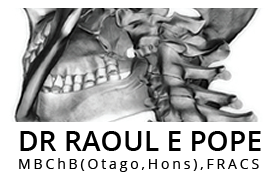Peripheral Nerve Conditions
What are Peripheral Nerves?
Anatomy
The human nervous system consists of four parts: the brain, spinal cord, autonomic nervous system, and peripheral nerves. Peripheral nerves are cord-like structures containing bundles of nerve fibers that carry information from regions of the body to the spinal cord (and vice versa). Constructed in a fashion similar to telephone cables, peripheral nerves have a tough outer layer of connective tissue that surrounds discrete groups of miniscule fibers, called "axons," each originating from its own nerve cell.
Peripheral Nerve Function
The primary function of a peripheral nerve is to transmit signals from the spinal cord to the rest of the body, or to transmit sensory information from the rest of the body to the spinal cord. For example, to flex a muscle, the brain sends a signal to the spinal cord that is received by a motor neuron in the spinal cord. This neuron sends the signal down an axon, which may be up to 3 feet long. This axon terminates in a muscle, where the impulse to flex is received. Once the muscle receives this signal, it flexes. The whole process requires only a fraction of a second to occur. Some nerves in the body, such as the sciatic nerve, are quite large and can be over 1 cm in diameter. Other peripheral nerves are so small that they cannot be readily seen without magnification.
Overview of Peripheral Nerve Entrapments
Peripheral nerve entrapment occurs when a nerve suffers from chronic compression along its normal anatomical course. Nerves normally are found within smooth channels or hollow spaces between bones, muscles, or ligaments. These spaces can become narrowed due to a variety of causes. For example, ligamentous scarring from trauma, bony enlargement due to arthritis, or muscle enlargement from overuse can all narrow the space available for nerves, compressing them. When nerves are compressed, their blood supply is reduced, a condition called ischemia. To illustrate, sometimes a person will fall asleep on their arm, impairing the circulation to the extremity. When the blood supply drops, the nerves stop working properly. When the person wakes up, the arm may feel "asleep." There may be "pins-and-needles" sensations, or even weakness. These sensations go away once the circulation is reestablished. Similarly, when a nerve is chronically compressed ("peripheral nerve entrapment"), the resultant ischemia may cause abnormal sensations and weakness as well.
Peripheral nerve entrapments are typically treated conservatively at first. Physical therapy and splinting are attempted for several weeks. If no improvement occurs, the nerves undergo decompression. This is a surgical procedure in which the structures that are compressing the nerves are divided or even removed, thus relieving the compression. Commonly patients experience an immediate partial relief of symptoms, followed by a more delayed recovery phase that can require several weeks, months, or even years, depending upon both the location as well as the severity of the injury.
VIDEO-OPEN CARPAL TUNNEL PROCEDURE
Overview of Peripheral Nerve Tumours
Tumours of almost any type can form along peripheral nerves. Most commonly, these are entirely benign Tumours that do not metastasize to other parts of the body. Generally slow growing, these Tumours can form within the substance of the nerve itself, and cause the nerve to gradually expand. Untreated nerve Tumours begin to compress the adjacent nerve fibers, causing nerve dysfunction. Patients may experience pain, numbness, and/or weakness in the distribution of the affected peripheral nerve.
In almost all cases surgical excision to obtain a diagnosis and to cure the tumour is indicated. It is important to have an experienced peripheral nerve surgeon perform this operation, as most peripheral nerve Tumours form within the nerve itself, and thus are surrounded and intertwined with functional nerve fibers that must at all costs be preserved during removal of the tumour.
In very few cases, the tumour is so involved with the peripheral nerve that complete excision is impossible without sacrificing the nerve. Generally your peripheral nerve surgeon will be able to tell from your MRI scan whether this is likely to be the case before the surgery is performed.
Malignant peripheral nerve Tumours are rare, but do occur. There is often no way to tell for sure preoperatively if a tumour is malignant. Pathological analysis of tumour tissue obtained via open surgery is the only way to know for sure if a tumour is malignant.
Some physicians (who are invariably not peripheral nerve surgeons) are tempted to perform needle biopsies of nerve Tumours. This unfortunate procedure often not only fails to obtain diagnostic tissue, it almost uniformly damages the normal nerve fibers that surround the nerve tumour tissue. Thus, the procedure is not only useless, but it can cause irreparable weakness, numbness, and horrific neuropathic pain.
Overview of Peripheral Nerve Injuries
Since peripheral nerves are found throughout the body, nearly any type of injury can result in damage to one or more peripheral nerves. Nerves may be severed, stretched, contused, blown apart, crushed, torn, or avulsed from the spinal cord. The type of treatment and timing of treatment depend entirely upon the mechanism of injury. For example, some injuries are best treated immediately; some require a period of observation lasting weeks to months, so that spontaneous recovery can occur without the need for surgery.
That is why it is so important to see a specialist in peripheral nerve surgery as soon as possible after your injury occurs. That way, you will not suffer the frustration of having a permanent disability because it is too late to repair your peripheral nerve injury.
http://www.pennstatehershey.org/web/neurosurgery/patientcare/specialtyservices/peripheral



